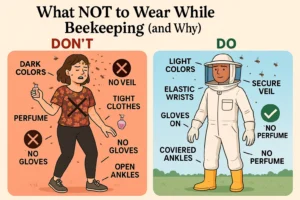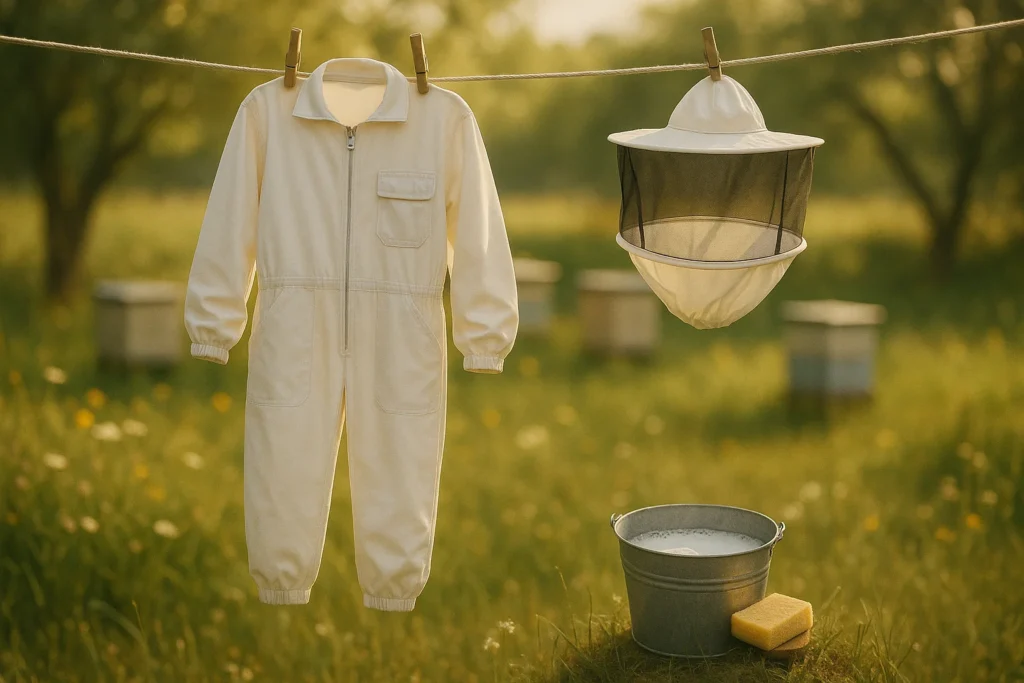
🐝 Gear Up. Stay Safe. Protect the Hive. 🌼
Beekeeping is more than a weekend hobby or a way to harvest golden jars of honey. It’s a Beekeeper Lifestyle — one that often extends far beyond the apiary. Yet, while most beekeepers spend hours researching hives, bees, and tools, they often overlook a surprisingly important detail: how and where to store their gear, especially their beekeeping suits.
After all, your suit is your armor — your barrier between sting and safety. Improper storage can shorten its life, cause odor buildup, introduce mold, and even make it less effective at protecting you.
This blog will walk you through everything you need to know about storing beekeeping suits — from post-use care to closet tricks, and even how to protect your gear in humid climates. Because if you take care of your suit, it’ll take care of you.
After a long session in the bee yard, your suit isn’t just sweaty — it’s probably coated in bee pheromones, propolis, pollen dust, and smoke residue. If you throw it directly into your closet, you’re inviting trouble.
What you should do immediately after using your suit:
💡 Pro Tip: Add a splash of white vinegar to your rinse cycle — it helps neutralize any lingering bee alarm pheromones.
Once your suit is clean and dry, how you fold and store it makes all the difference. Just like you treat your bees with care, your suit deserves the same.
✅ Ideal Folding Method:
❌ Avoid These Mistakes:
Stiff, crumpled suits are not only harder to wear but also risk punctures — something you can’t afford when working with stingers.
If you live in a humid climate or store your gear in places like garages, mold and moisture will quickly become your worst enemies.
Here’s how to protect your suit in moisture-prone areas:
🌿 Want it to smell fresh? Use a muslin pouch filled with dried lavender or cedar shavings to naturally repel insects and odors.

Whether you’re running mobile inspections or attending bee workshops, storing your suit safely while traveling is essential.
✈️ Flying? Pack your smoker and sharp tools in checked baggage, but your beekeeping suit can go in your carry-on.
Location matters more than you think when it comes to gear longevity.
🏡 Best Places:
🚫 Avoid These:
Having a dedicated storage space promotes routine, helps avoid last-minute panics, and keeps your beekeeping life organized.
Here’s how to care for other essentials in your beekeeping toolkit:
| Gear Item | Storage Tip |
|---|---|
| Gloves | Wash, dry flat, and store in a breathable bag |
| Veil | Roll loosely — never fold harshly |
| Smoker | Empty ashes, clean soot, store in metal box |
| Hive Tools | Wipe clean, oil lightly, hang on a rack |
| Boots | Air out, place in a dry, cool space |
🛠️ Tip: Hang your tools vertically using wall hooks. It saves space and looks professional too.
The Beekeeper Lifestyle is more than honey harvests — it’s a way of living with purpose, organization, and respect for the craft. When you store your gear with care, you’re showing commitment not just to safety and longevity, but to the harmony between you and your hive.
A clean, well-stored suit brings peace of mind, keeps bees calmer, and saves you from stress during inspections. You’ll move with confidence, knowing your protective gear is intact, your tools are in place, and your mind is clear.
So, next time you take off that bee suit, don’t just toss it. Fold it with pride, store it with love, and live the Beekeeper Lifestyle every step of the way. 🐝✨
